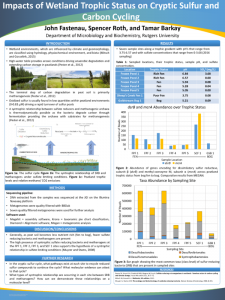Fastenau, John: Impacts of Wetland Trophic Status on Cryptic Sulfur and Carbon Cycling
Listen to the audio presentation
Title: Impacts of Wetland Trophic Status on Cryptic Sulfur and Carbon Cycling
Name: John Fastenau
Major: Biology and Spanish
School affiliation: School of Arts and Sciences
Programs: Honors College Capstone
Other contributors: Tamar Barkay and Spencer Roth
Abstract: Wetlands environments are vast and varied throughout the world. Generally, they are considered transitional environments between terrestrial and aquatic systems where the water table is at or near the surface or the land is covered by shallow water. Aerobic and anaerobic degradation of complex carbon stored in wetland peat soil occurs through many processes leading to methane and carbon dioxide formation. Studying the metagenomes of these environments provides insight into processes and microorganisms involved in carbon degradation and its relation to the sulfur cycle in these relatively sulfate poor ecosystems. Using the Amarel computing cluster at Rutgers University and various other assembly, alignment, annotation and analysis software, differentially abundant genes and taxa were identified across nutrient gradients in peatland wetlands in Alaska giving evidence for potential community structures within each trophic status. Specifically, it was observed that as nutrient status decreases, sulfate reducing microorganism (SRM) and methanogen abundances decrease except for site Sheep’s Creek Fen 1 (SCF 1), a poor fen. My results indicate the presence of SRM taxa and associated genes specifying cryptic sulfur cycle functions suggesting an active sulfate reduction in the peatland. Moreover, as wetland trophic status decreases, so do the abundances of SRM and cryptic sulfur cycle genes. Potential archaeal families including Archaeoglobaceae and Theinarchaea, were identified among SRM suggesting a role for these taxa in the cycling of sulfur. Molecular evidence for syntrophic microbial relationships was most pronounced in the SCF 1 site given that SRM metabolism would favor fermentation due to the site’s poor fen trophic status and the great abundance of SRM and methanogenic genes and taxa present at the site. Overall, this research offers insight into the community structure and functionality of Alaskan peatlands as a carbon sink pointing to the importance of further research into gaseous emissions from these sites and their influence on global carbon accumulation.
